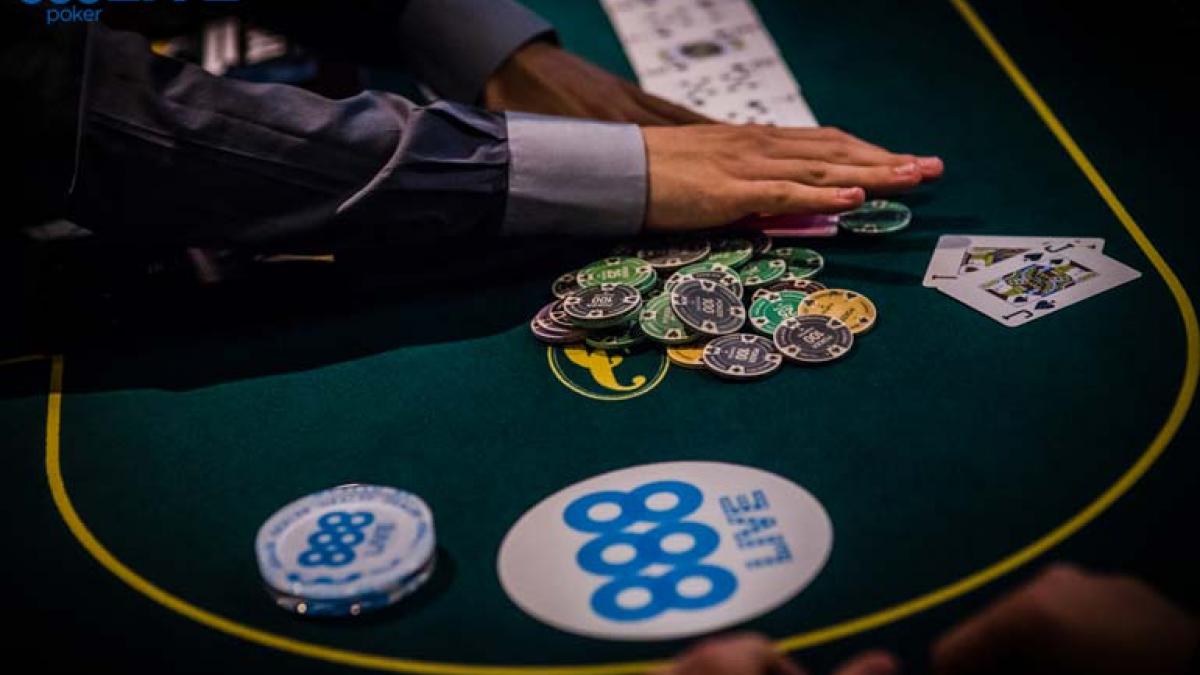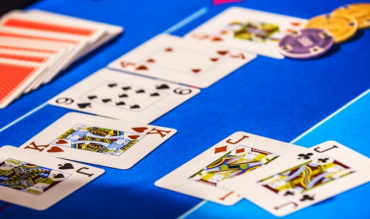Understanding board texture in poker can make the difference between breaking even and crushing for a high win rate.
But let’s not get ahead of ourselves. What exactly is board texture in poker and why is it so important? What are the different types of poker board texture? How can we use our knowledge of board textures to gain a strategic advantage?
In this 888poker guide to board poker textures, we’ll answer the important questions that will help you on the road to mastery.
What is Board Texture in Poker?
Board texture in poker describes how the three cards on the flop interact with each other.
Different arrangements of flop cards are referred to as different “board textures.” We consider whether the cards on the flop connected, allowing for possible straight and flush draws. We also consider whether there are high cards on the board or whether the board is paired.
What is the Importance of Reading the Board Poker Texture?
Good poker players make educated guesses at the types of hands their opponents are likely to have. Our opponent is more likely to be strong on specific types of poker board texture but weak on others.
Armed with this knowledge of poker board textures we will be able to play more aggressively when our opponent is likely to be weak and more cautiously when he is likely to be strong.
Whether a player connects well with the board will be heavily related to whether they are the preflop aggressor or preflop caller. Here is a quick recap of those two terms 🡪
• Preflop aggressor – The player who takes the last aggressive action on the preflop betting round.
• Preflop caller – The player who closes the action on the preflop betting round by just calling.
What is a ‘Wet Board’ in Poker?
A ‘wet board’ in poker is one where there are lots of draws available, especially in the mid region. For example, 7d8h9h is an example of a “wet board” because there are many straight and flush draws available.
Wet flops are typically more favorable for the preflop caller rather than the preflop aggressor.
What is ‘Dry Board’ in Poker?
A “dry board” in poker is one where there are few or zero draws available. The classic example of a dry board is Kd7h2s. There are zero flush or straight draws available on this texture.
Dry flops are typically more favorable for the preflop aggressor rather than the preflop caller.
What is a ‘Rainbow Board’ in Poker?
A rainbow poker board game is one where all three cards are of a different suit; for example KdTs4c.
Straights and straight draws go up in value on rainbow boards because it’s less likely that our opponent will be able to defeat our straight with a possible flush by the river.
Backdoor draws (draws that require running cards on both turn and river) also go up in value on rainbow textures since there are fewer direct draws available.
What is a ‘Two Tone’ Poker Board?
A “two tone” poker board is one where there are two cards to the flush directly on the flop. For example, Js7s2c.
Straight draws and straights go down in value on a two tone texture since there is a higher chance our opponent can defeat our straight with a made flush by the river.
Backdoor draws also go down in value on two tone textures since there are a larger number of direct draws available.
What is a Monotone Poker Board game?
A “monotone” poker board is one where there are three cards all of the same suit. An example of a monotone board texture is Th7h2h.
This is 888poker's guide to poker board textures when playing No Limit Hold'em. Learn the 11 different poker board textures along with strategy advice.

Due to the high availability of flushes and flush draws, most other hands go down in value.
While sets are still fairly strong, pairs and straight draws without the flush draw end up being significantly weaker than usual on a monotone texture.
The List of Board Poker Categories
There are 19,600 possible different flops in poker. This is a problem since it’s highly unlikely we have the time to study all of them in depth.
Smart players tend towards grouping the different poker board textures into broader categories. Strategy for each of the boards in a category should share many similarities.
The challenge is to create a concise list of poker board categories that still provides reasonable coverage of every possible texture type. Thankfully at 888poker we have done the hard work for you!
Board Poker No. 1 – Single Broadway Dry
This poker board contains a single high card Jack or higher. There is relatively little coordination between the other cards hence the term “dry.”
Example poker board: Kd8s3h
This type of board is good for the last preflop aggressor, allowing them to play aggressively. According to theory, small bet sizings should nearly always be used on this type of board texture.
Poker Board No. 2 – Single Broadway Dynamic
This poker board also contains a single high card of Jack and higher. The key difference is that there is now significant coordination between the other two cards on the flop.
Example poker board: Ad9h8h
Although this type of board is generally still good for the preflop aggressor, the preflop caller connects harder here than he would on the dry single broadway category.
According to theory, the preflop aggressor should now use a range of different bet sizings on this poker board texture, but rarely overbet (i.e. he should not bet larger than the current size of the pot).
Poker Board Game No. 3 – Double Broadway
This poker board contains two cards ten or higher hence “double broadway.”
Example poker board: AsQd4c
The double broadway texture is extremely good for the preflop aggressor. In most cases this is because the preflop aggressor can have both top set and second set in his hand range while the preflop caller would have usually re-raised preflop if he had those starting hands.
According to theory, not only should the preflop aggressor play very aggressively on this board texture but he should also be using an overbet sizing at a high frequency.
Poker Board No. 4 – Triple Broadway
This poker board contains three cards ten and higher.
Example poker board: AsQdTc
Although this type of board is very favorable for the preflop aggressor, it is no longer theoretically correct to make use of overbet sizings (at least, not often).
This is because the preflop caller will still be capable of holding the nut straight some of the time.
According to theory, it is correct to use a range of different bet sizings on this board category but nearly always smaller than pot size.
Poker Board No. 5 – Mid Dry
This poker board features a high card between 7 and 10. There is relatively little coordination between the cards. (Note that coordination between low cards doesn’t make the board that much “wetter”).
Example poker board: Ts3c2s
This mid dry board is generally better for the preflop aggressor, but there are lots of ways that the preflop caller can improve to a top pair or better by the river.
According to theory the most common sizings on the mid dry board are either small (think 33% pot) or an overbet (think 125% pot). Middling sizings (50% pot) are still used however.
It’s good to be able to identify this type of board texture when it crops up since it is frequently correct to overbet overpair type hands as the preflop aggressor in single raised heads up pots.
Poker Board No. 6 – Dynamic
This poker board features mid range co-ordination but not enough of it for a straight to be directly possible.
Example poker board: 9s7s4c
These types of boards are usually better for the preflop caller, meaning that the preflop aggressor should be betting less frequently.
According to theory, the preflop aggressor should be using a range of sizings up to around 80% pot but rarely or never overbetting.
The preflop defender can easily have top and second set here since he would not necessarily have re-raised these hands preflop (depending on the action).
Board Poker No. 7 – Code Red
This type of board features heavy mid range co-ordination that makes a straight directly possible.
Example poker board: 7d8d9c
These are typically the best types of boards for the preflop caller meaning the preflop aggressor should play very cautiously.
Like the dynamic texture, the preflop aggressor should be using a range of sizings up to around 80% pot but rarely or never overbetting.
Poker Board No. 8 – Low
This poker board has a high card of 6 or lower.
Example poker board: 6d3c2c
Although the low board has a possible straight it is nowhere near as dangerous to the preflop aggressor as the code red board texture. The reason is that the preflop caller is less likely to be defending preflop with two very low ranked hole cards.
In theory, the preflop aggressor uses medium aggression and a range of small to medium sizings (30-50% pot).
Poker board Game No. 9 – Monotone
This poker board contains 3 cards all of the same suit.
Example poker board: Qh8h6h
The defining feature of this board is that all three cards are of the same suit. Our approach to strategy should be similar regardless of the exact ranks of the cards.
It's nearly always correct to make use of small bet sizings on a monotone texture as the preflop aggressor.
Poker board No. 10 – Paired Dry
This poker board texture has two cards of the same rank. Aside from this there is little to no coordination on the board.
Example poker board: KsKd2c
Usually dry boards with a pair should be played extremely aggressively by the preflop aggressor. However, it’s nearly always correct to use a small bet sizing.
It's correct to play three of a kind textures like KKK even more aggressively, but since these boards happen so rarely we can consider them a subcategory of the paired dry board.
Poker board No. 11 – Paired Dynamic
This poker board texture has two cards of the same rank but there is also a decent amount of mid-range coordination.
Example poker board: ThTd9d
Due to the mid range coordination, this board is not as good for the preflop aggressor as the paired dry texture.
Aggression levels are therefore lower here although the preflop aggressor is supposed to make use of some slightly larger (50% pot) bet sizings in theory.
Summary of Board Textures
Let’s recap on what we have learned regarding board textures.
• Wet boards with lots of mid-range coordination are usually better for the preflop caller.
• Drier boards with one or more high cards are usually better for the preflop aggressor.
• We can group any board texture into one of the 11 categories listed above.
• Boards in the same category should usually be played with a similar approach to aggression levels and bet sizing.


